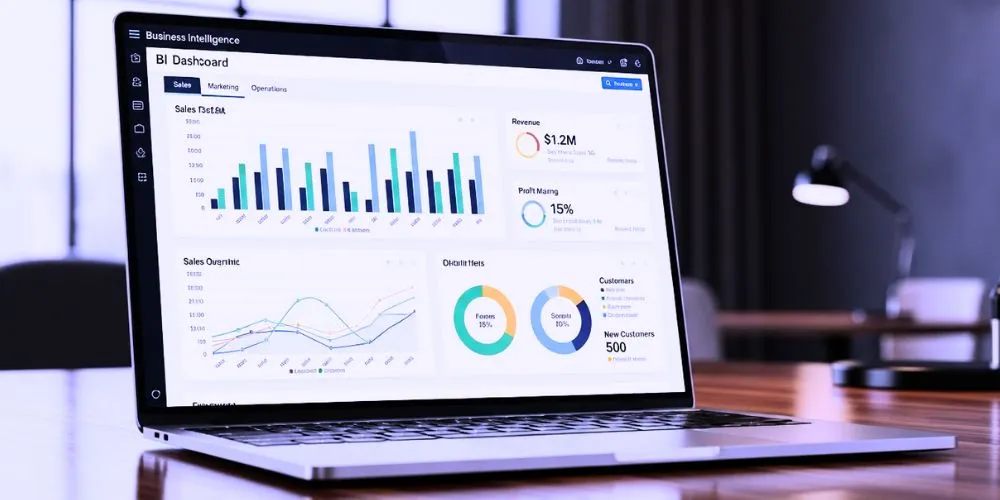In today’s fast-paced and data-driven world, businesses and organizations are inundated with vast amounts of information from various sources. Extracting valuable insights from this sea of data is crucial for making informed and strategic business decisions. This is where a Business Intelligence (BI) system comes into play. A Business Intelligence system is a comprehensive approach that leverages technology and analytics to collect, analyze, and visualize data, enabling organizations to gain deeper insights and make data-driven decisions. In this article, we will explore the significance of a Business Intelligence system, its key components, and its benefits in illuminating critical data for strategic decision-making.
Understanding the Business Intelligence System
A Business Intelligence system is a set of tools, technologies, and processes that transform raw data into meaningful and actionable information. It encompasses a series of steps to turn data into insights:
- Data Collection and Integration: The first step in a Business Intelligence system is gathering data from various sources such as databases, spreadsheets, cloud applications, and external datasets. This data is collected and integrated into a centralized data warehouse, creating a unified and accessible repository for analysis.
- Data Modeling and Transformation: Raw data needs to be processed and transformed into a usable format to derive meaningful insights. Data modeling involves structuring the data to allow for efficient querying and analysis. Transformation processes cleanse and enrich the data, ensuring its accuracy and consistency.
- Analytics and Reporting: Analytics is the heart of a Business Intelligence system. It involves using various techniques, including statistical analysis, data mining, and machine learning, to uncover patterns, trends, and correlations within the data. The insights gained from analytics are presented through reports, dashboards, and visualizations.
- Data Visualization: Data visualization is a crucial aspect of a Business Intelligence system. It presents complex data in a visually appealing and easy-to-understand format. Interactive charts, graphs, and infographics help users interpret the data quickly, enabling them to spot trends and anomalies effectively.
- Business Performance Management: A Business Intelligence system enables organizations to monitor key performance indicators (KPIs) and track progress toward business goals. Business Performance Management tools provide real-time insights, empowering decision-makers to take prompt action when necessary.
Critical Components of a Business Intelligence System
When it comes to building a successful business intelligence system, a few essential components must be considered. First and foremost, the system must be able to gather and store large amounts of data from multiple sources.
- Data Integration and Warehousing: Data integration involves collecting data from disparate sources and transforming it into a standardized format before storing it in a central data warehouse. It ensures that data is consistent and easily accessible for analysis.
- Data Modeling and Transformation: Data modeling is designing the data structure in the data warehouse. It involves defining relationships between different data elements, allowing efficient querying and analysis. Data transformation includes cleaning and enriching the data, ensuring it is accurate and reliable for decision-making.
- Analytics and Reporting: The core of a Business Intelligence system lies in its ability to analyze data and generate meaningful reports and visualizations. Advanced analytics techniques, such as descriptive, predictive, and prescriptive analytics, are used to uncover insights and trends from the data.
- Data Visualization: Data visualization tools create interactive and intuitive visual representations of the data. It allows users to explore the data visually, making it easier to identify patterns, outliers, and relationships.
- Business Performance Management: Business Performance Management tools enable organizations to set goals, track KPIs, and measure progress in real-time. It helps stakeholders make data-driven decisions and take corrective actions promptly.
Benefits of a Business Intelligence System
One of the key benefits of a business intelligence system is that it allows businesses to make data-driven decisions based on real-time insights. It can help to improve efficiency, reduce costs, and increase overall profitability.
- Informed Decision-Making: A Business Intelligence system empowers organizations to make well-informed decisions by providing decision-makers with accurate and up-to-date information. This data-driven approach leads to better business strategies, improved operations, and a competitive edge in the market.
- Improved Operational Efficiency: A Business Intelligence system streamlines the process of data integration, modeling, and analysis, reducing the time and effort required to access critical information. This efficiency boosts operational performance and empowers employees to focus on strategic tasks rather than manual data processing.
- Identification of Opportunities and Risks: Business Intelligence systems uncover hidden opportunities and potential risks within the data. Organizations can capitalize on emerging trends and mitigate potential threats, staying ahead of the competition and market dynamics.
- Enhanced Data Governance and Compliance: Centralizing data in a data warehouse enhances data governance and security. A Business Intelligence system ensures data integrity, reduces data silos, and helps organizations comply with data protection regulations, ensuring the confidentiality and privacy of sensitive information.
- Customer Insights and Personalization: Analyzing customer data through a Business Intelligence system provides valuable insights into customer behavior, preferences, and needs. This information facilitates personalized marketing strategies, improved customer satisfaction, and higher customer retention rates.
Conclusion
A Business Intelligence system is indispensable in today’s data-driven business landscape. By collecting, analyzing, and visualizing data, organizations gain valuable insights that empower them to make informed decisions, optimize operations, and capitalize on opportunities. Implementing a robust, it enables organizations to stay competitive, adaptive, and thriving in an ever-evolving market. As data continues to be the lifeblood of modern businesses, harnessing its power through a Business Intelligence system becomes a strategic imperative for sustained growth and prosperity.













